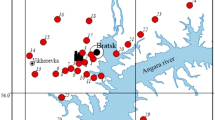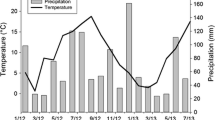Abstract
The mesophyll structure of current and second year needles of mature Scots pines (Pinus sylvestris L.), growing on a survey line from the Karelian Isthmus (N.W. Leningrad region, Russia) to S.E. Finland, was studied at the light microscopic level in 1992 and 1994. The area is affected by sulphur dioxide and nitrogen oxide emissions from Russia (200 000–285 000 ton/year SO2 and about 100 000 ton/year NOX), Estonia (140 000–320 000 ton/year SO2 and 30 000–50 000 ton/year NOX) and Finland (6000–9000 ton/year SO2 and 23 000–25 000 ton/year NOX) and by unknown amounts of neutralizing compounds from Estonia. Mean concentrations of SO2 were between 1.0 and 1.5 μg m–3 and those of ozone between 52 and 61 μg m–3 during growing seasons of 1991–1994. The concentrations tended to be lower in 1993/94 than in 1991/92. The results showed cellular changes related to exposure to sulphur dioxide, ozone and acid wet deposition. The percentage of cells with injuries related to acid deposition was higher in 1994 than in 1992, possibly due to higher reduction of neutralizing than of acidifying compounds in the main emission areas, while the percentage of cells with injuries related to sulphur dioxide correlated positively with needle sulphur concentrations and showed a declining trend between Karelian Isthmus and S.E. Finland in the needles sampled in 1992. These changes and those related to ozone were considerably less numerous in 1994 than in 1992, possibly on account of the lower concentrations of SO2 and ozone in 1993/94 than in 1991/92, especially in early summer, the time of the most sensitive phase of needle growth. In addition, periods of lower wet deposition in summer 1992, and considerably lower temperatures in autumn/winter 1992 than in 1994 may have enhanced the injuries in the needles collected in October/December 1992, relative to those collected in 1994. The results of the microscopic work agreed well with the simultaneous chemical measurements, pointing to the usefulness of cellular analysis for diagnostic work in the field.
Similar content being viewed by others
Author information
Authors and Affiliations
Additional information
Received: 26 September 1997 / Accepted: 24 November 1997
Rights and permissions
About this article
Cite this article
Sutinen, S., Lumme, I., Mäenpää, M. et al. Light microscopic structure of needles of Scots pine (Pinus sylvestris L.) in relation to air pollution and needle element concentrations in S.E. Finland and the Karelian Isthmus, N.W. Russia. Trees 12, 281–288 (1998). https://doi.org/10.1007/PL00009718
Issue Date:
DOI: https://doi.org/10.1007/PL00009718




